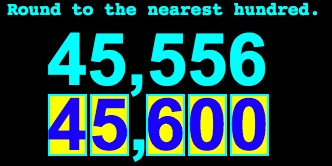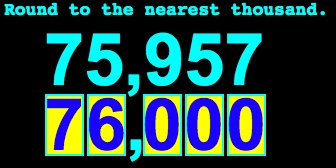
|
Arithmetic - Number Sense - Rounding
Rounding:
Rounding off a number is a form of estimation which can be useful when only an approximate value is needed.
Rounding to the nearest 10:
- The value in the ones column will always change to zero.
- The value in the tens column will either stay the same (called rounding down) or increase by one (called rounding up).
- If you are rounding up and the value in the tens column is nine, then it is changed to ten and the zero will be placed in the tens column and the one will be carried to the hundreds column. Warning: This could cause a chain reaction!
- To decide whether to round up or down, look at the value in the ones column. If it is five or more, round up. Otherwise, round down.

Rounding to the nearest 100:
- The values in the ones and tens columns will always change to zero.
- The value in the hundreds column will either stay the same (called rounding down) or increase by one (called rounding up).
- If you are rounding up and the value in the hundreds column is nine, then it is changed to ten and the zero will be placed in the hundreds column and the one will be carried to the thousands column. Warning: This could cause a chain reaction!
- To decide whether to round up or down, look at the value in the tens column. If it is five or more, round up. Otherwise, round down.

Rounding to the nearest 1000:
- The value in the ones, tens, and hundreds columns will always change to zero.
- The value in the thousands column will either stay the same (called rounding down) or increase by one (called rounding up).
- If you are rounding up and the value in the thousands column is nine, then it is changed to ten and the zero will be placed in the thousands column and the one will be carried to the ten-thousands column. Warning: This could cause a chain reaction!
- To decide whether to round up or down, look at the value in the hundreds column. If it is five or more, round up. Otherwise, round down.

Click here to go to the activity
